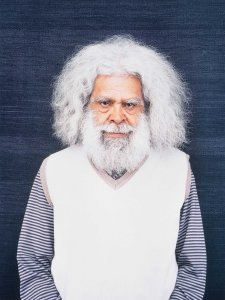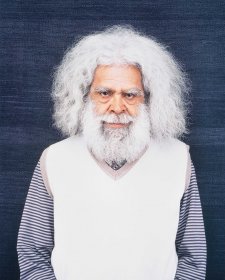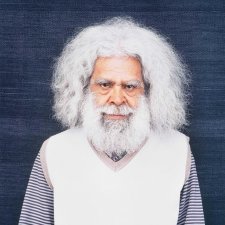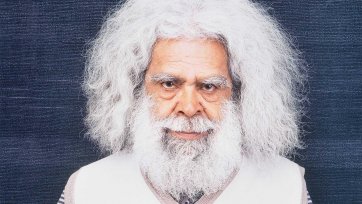Before the deluge - with flood waters rising rapidly in the inner city Brisbane suburb of Newfarm - a handful of local residents decided to hang on and wait out the flood peak forecast for early the following morning. In this photograph it was Michael Dwyer, aged 94, refusing to leave his home of 60 years and move to safe ground, with his granddaughter, Gabrielle Dwyer, waiting it out beside him.
Questions
1. What does this double portrait tell you about the relationship between the subjects? How is this conveyed in the portrait?
2. If this photograph was reproduced in a newspaper article, what caption would you write to accompany the image?
3. How does the title of the portrait influence your reading of the image?
The photographer and the portrait -
an interview
How do you define your practice?
My practice is continually changing and it is difficult to categorise definitively - it sometimes includes aspects of photojournalism, portraiture, student workshops, and even commercial work - so 'photographer' would be the best description. Currently I have a range of work, including commercial work for publications, ongoing documentary projects from Australia and the Asia-Pacific, and lots of personal work. It's a balancing act between survival and art!
Do you have a website or are you represented on a website?
anthonyanderton.com I have had a website in some form right from the outset. Having a website or some electronic platform for your work is very important for a photographer. However, it is essential to constantly update and refresh site content, and direct as much traffic as possible to your website.
What is your relationship to the subject?
I had never met the subject of my portrait before so I tried to build rapport and a sense of trust under challenging circumstances!
Was the photograph a result of a constructed or candid encounter?
The photograph is the result of an unplanned, candid encounter - although I set out over a series of days to visit and photograph specific parts of Brisbane that were being affected by the January 2011 floods. I visited this area twice during the floods and decided that I would have to wade out through the flooded streets to get as close as possible to the people experiencing the floods. My portraits are often the outcome of this combination of a planned visit or structured project and unexpected or unplanned encounters. I first started taking general photographs of the flooded street, then moved closer to a house and struck up a conversation with the occupants. For images like this I think it is important to establish some level of personal rapport and to talk about why I am taking photographs (especially in circumstances that are sensitive or distressing). For this photograph I spent some time talking about the impact of the flood before I asked if I could take the portrait.
What are the ideas or themes underpinning your portrait?
I wanted to document the reality of the flood as it happened - and where possible capture how the flood was affecting people. This image tries to combine the massive and devastating impact of the 2011 Brisbane flood with one individual's determined response to it. This goal influenced my decisions on how I constructed the framing and composition of the image - hopefully successfully.
Describe the technical aspects of your photograph.
The image was taken hand held using available natural light, and I would not use flash for images like this. The camera was a Nikon D700 digital SLR fitted with a 17-35mm F2.8 lens. The image has not been enhanced or manipulated beyond minor cropping at the edges and basic adjustments needed for printing and exhibition.
How was the final print made? Is this print one of an edition?
The exhibition print was produced by a professional printer from a digital master file (the final version of the print file needs to be saved). I always edition my exhibition prints. The size of the edition varies but I usually use editions of 50. I retain the first and last in the edition.
Describe your consideration of scale, mounting and framing in the presentation of your portrait?
I wanted to present the print as simply and directly as possible so I selected plain framing and mounting materials. The framing was done by a reputable framer who I have worked with for a number of years. The print size was chosen to balance the technical constraints of enlarging from a 35mm format and the scale needed for exhibition and gallery viewing.
Who would you nominate as your influences?
Too many to list all (and I can only aspire to get anywhere close to their work) - but include Ernst Haas, Harry Callahan, Walker Evans, Hiroji Kubota, Stephen Shore, Eve Arnold, Steve McCurry, Eugene Smith and David Moore - and many, many more.
Do you have any advice for a beginning photographer (e.g. students)?
The most rewarding and creative opportunities are right in front of you, things that lie in the everyday, in your personal interests and passions, literally in your backyard. The challenge and the exhilaration of photography is striving to capture the ordinary and the overlooked in a way that brings it to life and makes someone turn and look again. And you do not need state of the art, expensive and often intimidating equipment to make this happen.














